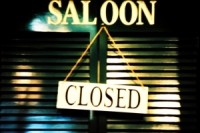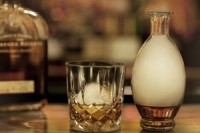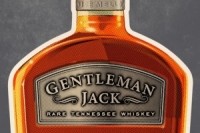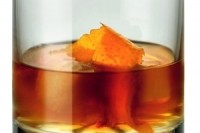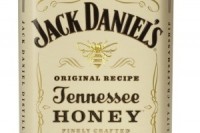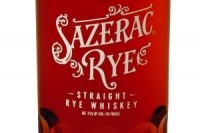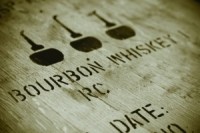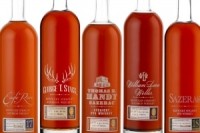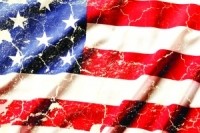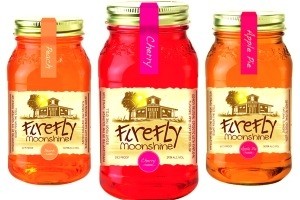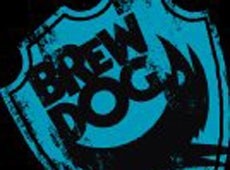Old-fashioned cool: The trend for American whiskey

Johnny Cash wore black because everyone else donned Rhinestones and cowboy boots. He wanted to see if people could see what he was about, without the need for sparkly attire. There were no illusions about ‘the man in black’ — and this is a theme that underpins American whiskey: understated cool.
Whiff of nostalgia
While hipsters reject the sense of soulless mainstream outlets and seek speakeasy-styled hideouts that emulate the décor of the Prohibition era, it’s a bit of a paradox to see how many self-styled ‘pop-up speakeasies’ there are nowadays.
Pubs and bars, quick to adopt the trend, are beginning to recreate a nostalgic style to attract more drinkers. And it’s paying off. But what do they all want to drink? American whiskey and Bourbon, that’s what.
In contrast to their parents’ generation, the average 20 to 35-year-old hipster’s palate craves sweetness and spice and not overly complex spirits with age statements.
43%
the proportion of American whiskey drinkers aged under 35
They want something discerning and flavoursome, but with culture attached. They don’t want a dad drink. American whiskey, in many ways, answers all of these needs.
Corn-based spirits such as Bourbon and Tennessee whiskey provide the sweetness, while rye whiskey gives a nod to spicier notes. Moonshine, meanwhile, or ‘White Dog’ as it is sometimes known, gives a hint of the illicit underground element.
Drinks served from teapots into jam-jar glasses, are part of the trend’s growing style, and TV shows such as Mad Men and Boardwalk Empire have resurrected early American cocktail culture. Blokes now feel at home ordering Old Fashioneds (a cocktail including sugar, bitters, whisky and citrus).
A great mixer
“The beauty of American whiskey as a category is that it lends itself to being served in a variety of different ways,” says Greg Adams, part of the bar training and development team at the Grill on the Market in Smithfield, City of London.
“Its sweeter, fruitier style means it mixes well as part of a cocktail or a simple spirit mixer, but can be equally enjoyable if simply drunk neat or on the rocks,” he says.
According to CGA Strategy, American whiskey is now worth £356.2m in the UK on-trade and category sales are up 5% this year. The top brands are: Jack Daniel’s, Maker’s Mark, Jim Beam and Bulleit — with Jack Daniel’s way out in front.
In fact, Jack Daniel’s, Jim Beam, Maker’s Mark and Bulleit all saw sales value rise compared to last year’s figures but it is Maker’s Mark that’s the real champ, rising 38% in value (MAT to June 2013). This year it has sold more than 16,000 cases, illustrating how much traction the brand now has in pubs and bars.
A sociable drink
So, why are we suddenly seeing young people getting into American whiskey? “There’s an approachability and sociability in what American whiskey offers and a sense of ‘I don’t want to drink what my dad drank’ and, ‘even though malt Scotch offers a huge sense of discernment, American whiskey offers a different type of discernment’,” says Crispin Stephens, Bacardi Brown-Forman Brands’ (BBFB’s) trade marketing manager for UK & Ireland.
Stephens points out that “with American whiskey it’s more about flavour and the pleasure you get from drinking it, whereas Scotch is much more about knowledge through the rules and the age”.
£356.2m
the value of the American whiskey market in the UK on-trade
Brighton pub group Indigo serves Buffalo Trace at its venues and in March hosted the Buffalo Bourbon Exchange pop-up bar at the Wick Inn in Hove, East Sussex.
Chris Broomfield, director of Indigo, says: “Buffalo Trace Bourbon fits very well in our overall drinks range. Bourbon cocktails and mixed drinks appeal to younger customers, and especially to groups meeting for a night out. The links between Bourbon and music mean that drinks made with Buffalo Trace are a popular part of our offer.”
Jeremy Hill, chairman at Hi-Spirits, says this is because “Scotch has built a mystique around its products, which is successful in terms of appealing to aficionados, but deters consumers still discovering the breadth of flavours and serves that the spirits category offers”, so in turn American whiskey and Bourbon are more accessible. He points out that “CGA Strategy figures show that American whiskey attracts a younger consumer than the whiskey category overall, with 43% of American whiskey drinkers aged under 35”.
This is a notion that Adams agrees with: “American whiskey seems to be taking advantage of the fact that Scotch brings with it an air of pretentiousness,” he says, explaining that “many view Scotch as something to be consumed neat, possibly with a dash of water, certainly not with Coke or as part of a long fruity cocktail. This rather outdated view of the spirit leaves many people feeling too intimidated by it”.
Old Fashioneds, Mad Men and mixing flavours
Cocktails have been a key driving force in the success of American whiskey, says CGA client services director Rachel Perryman, adding that “CGA’s Mixed Drinks Report 2013 revealed that the Old Fashioned is one of the top three cocktails consumed by men”.
BBFB’s Stephens reckons it has “grown with the rise of cocktail culture — TV shows such as Mad Men and Boardwalk Empire resurrected the vintage glamour and sophistication of urban American culture, leading to a resurgence of classic US whiskey cocktails and drink serves. People are inspired by the culture that they see in these programmes.
“The Roaring ’20s are renowned not only for their frivolity, but for the danger element of Prohibition, which appeals to today’s consumers. American whiskey has a natural link to this culture due to the impact of Prohibition on the various distilleries and states of the Deep South.”
Elliot Ball, bar manager and consultant at Shaker UK, thinks we also need to credit the current generation of drinkers for experimenting — and tip our hats to marketing departments for certain brands because, without them, there would be no spikes in sales of great spirits.
“Perhaps we can credit the growth of whiskey, not simply to a great TV show, but a generation for being receptive to it. Never before has there been such a group of young people so willing to embrace the habits and tastes of a previous cohort as ‘cool’,” says Ball.
He adds that “ultimately, though, we’ve seen the best kind of advertising for a spirit, along with a marked increase in quality, all amid the steady revival of specifically American mixed drinks”.
The beauty of US whiskey is that it lends itself to serves in a variety of ways
Hi-Spirits’ Hill says that “even a simple serve such as a Bourbon and cola has ‘cool’ connotations” and singles out the “Buffalo Trace Mint Julep, served chilled from the fridge as either a shot or long drink” as one of the brand’s signature serves worth adding to your pub’s offer.
Palates are getting sweeter
BBFB’s Stephens says: “The demand for sweeter tastes and flavours has enabled brands to leverage connections with typically non-whiskey drinkers, who often prefer sweeter serves and cocktails, reinvigorating the category and attracting a younger demographic.”
Jack Daniel’s, part of the BBFB portfolio, has begun to generate a buzz for its variant, Jack Daniel’s Tennessee Honey, with its summer campaign putting the brand on TV, in print, cinemas, on-line, as well as on taxis and the London Underground. A new range of PoS, which is helping the brand fly off the bar, is also available.
Since launching nine months ago, Jack Daniel’s Tennessee Honey has overtaken many of its competitors, become the number-one new spirit launch over the past two years, and is now worth more than £18.5m. And savvy licensees are getting in on the action and serving it chilled, over ice, or with a light mixer such as lemonade.
Adding flavour to the category is Red Stag by Jim Beam, which is in-fused with black cherry and was the first flavoured Bourbon to hit the UK, followed by Jim Beam Honey and Devil’s Cut. “Red Stag is perfect on its own or mixed with cola,” says Maxxium UK on-trade sales director Jim Grierson, who claims “the natural sweetness of the cherry-infused flavour works well as an ingredient in more sophisticated cocktails”.
Last September Maxxium UK launched Jim Beam Devil’s Cut, which is positioned as a more premium Bourbon and plays on the notion of ‘angel’s share’ — the liquid lost to evaporation during ageing.
The Old Fashioned is one of the top three cocktails consumed by men
Grierson adds: “Jim Beam’s distillers developed a technique to extract the Bourbon — or ‘devil’s cut’ — trapped in the barrel during this process. “The liquid, which takes on the natural elements of the wood, is added to an extra-mature Bourbon and bottled at 45% ABV, resulting in a deep, bold Bourbon, both in taste and colour,” says Grierson, describing it as “a premium-level entry point for 18 to 29-year-old consumers looking to enhance their drinks repertoire with a unique choice”.
Maxxium UK also unveiled 35% ABV Jim Beam Honey last year, the UK’s first-ever honey-infused Bourbon, which is made with four-year-old Jim Beam Bourbon whiskey, slowly infused with natural honey.
“One of the most notable developments in the category of late is the introduction of flavoured whiskies, with brands such as Jim Beam, Jack Daniel’s, Wild Turkey and Evan Williams releasing a range of flavoured expressions,” says the Grill on the Market’s Adams, suggesting that this is another updated element that has begun to gain the attention of younger hipsters.
Blurring of the categories
When something is added to a whiskey, it makes it a liqueur. And what we’re seeing with many drinks — American spirits included — is more blurring of the boundaries between one category and another.
Does this mean the way we define drinks is diminishing in importance for next-generation consumers? Perhaps so — after all, look at the blurring effect of flavoured ciders and spirit-beers. But for those who think it is important, there needs to be clarification.
Many people misunderstand the difference between the spellings of whiskey, whisky and Bourbon and wrongly assume that, for something to be considered a Bourbon, it has to be made in Bourbon County in Kentucky. Not true. Bourbon is a style of creation with its history being a reference to location, but it still remains a process and a style, not a grade based on geographical location. The same goes for Tennessee whiskey.
“When the whiskey comes off the still it is in its rawest form. If we were to take that whiskey today, and not pass it through the charcoal and put it into one of our barrels and start the ageing process, we’d be classified as a Bourbon,” says Jack Daniel’s tour operator Jesse James.
“They have called us a Tennessee whiskey,” says James, adding this is to do with the charcoal mellowing that creates the style of whiskey known as Jack Daniel’s.
“If you were to pick this operation up today and set it in the middle of Texas we’d still be classified as a Tennessee whiskey. It has nothing to do with where, but how.”
The way we define drinks is diminishing in importance for next-generation consumers
Certainly, it may be true that country of denomination is important for Scotch. It’s also a giveaway that American and Irish whiskey is spelt with an ‘e’, while Scottish whiskies, Canadian whiskies and Japanese whiskies omit the ‘e’ and call themselves ‘whisky’. Confused? Really, it is unsurprising that younger consumers are rejecting stuffy definitions and just drinking what they like based on flavour preference.
Bourbon on the up
In a Vinexpo report this year detailing UK spirits consumption, Bourbon showed a significant rise in volume sales between 2007 and 2011. In 2007, it exceeded the million case mark in the UK and, by 2011, almost 1.25 million were sold, a 17.6% upsurge in four years. Last year, 1.3 million cases of Bourbon were sold in Britain and figures in the report suggest that, by 2016, the number will reach 1.41 million.
By no means do American whiskey and Bourbon sell as much as Scotch. But then, what we are seeing within the Scotch category is a marked decline. For instance, in 2007, 6.8 million cases of Scotch were sold but by 2011 this had dropped to 6.3 million — a decline of 7.3%.
“There is no doubt the increasing number of speakeasy-style outlets, dive bars and gourmet junk-food venues are facilitating these trends, and as a result CGA has seen an increase in the number of American whiskeys that outlets stock,” says CGA’s Perryman.
Initiatives such as the speakeasy-style Buffalo Bourbon Empire pop-up bar have helped build sales of serves such as the Boilermaker [beer followed by a shot of whiskey — a Buffalo Trace chaser in the case of this bar] and Pickleback [a shot of whiskey chased by a shot of pickle brine].
“Interestingly, we’re also seeing a number of bartenders develop flavoured infusions using Buffalo Trace White Dog,” says Hi-Spirits’ Hill.
White Dog and rye whiskey
“Rye whiskey has also been resurgent in the marketplace and I think we were fairly ahead of the curve on it,” says Jack Daniel’s James, alluding to the brand’s un-barrelled rye, which is clear in colour and straight off the still, but uses 70% rye, instead of majority corn.
“Rye offers a spiciness to whiskey that corn just doesn’t,” says James, hinting that years ago people simply “made whiskey with what was around — and in the south we have a lot of corn”.
But he adds: “If you go into Canada, the predominant grain is rye, because it’s a cold weather grain. In Tennessee it’s too hot. In Scotland, barley is everywhere — that’s why most Scotches are made from barley.”
Hi-Spirits’ Hill says: “There are no sacred cows where Bourbon is concerned, which makes it very different to Scotch, with its ‘heather and weather’ marketing.” And it is this that makes it identifiable for younger generations. There’s nothing aloof about it, and it has broad appeal because there’s so much variety.
“Everything from Bourbon cocktails and flavoured variants through to innovations such as Buffalo Trace White Dog — the unaged clear Bourbon — encourages bartenders and consumers to enjoy the huge variety of whiskey offers, both on its own and in cocktails,” he adds.
And the Grill on the Market’s Adams agrees there’s still scope for American whiskey to gain more traction in the UK.
“Public awareness of the category is growing all the time. Over the coming years, I see American whiskey going in much the same direction as gin and rum have recently, with consumers becoming more discerning about what they order.”
It seems that, right now, pubs are only just scratching the surface.
American whiskey at a glance
■ Bourbon — a type of American whiskey that is a barrel-aged distilled spirit made primarily from corn. Its name comes from the area known as Old Bourbon, around what is now Bourbon County, Kentucky, but can be made anywhere in the US.
■ Corn whiskey — an American whiskey, with corn making up 80% of its ingredients.
■ Malt whiskey — an American whiskey where more than half of the primary ingredients are malted barley.
■ Moonshine — this is a high-ABV spirit, often distilled illegally. Moonshine is named due to the illicit nature of its creation — ie: made and distributed in a clandestine way under the cover of darkness or ‘by the light of the moon’.
■ Rye whiskey — a type of American whiskey in which rye makes up more than half of the primary ingredient (with the other ingredients usually being corn and malted barley) before being aged in charred new oak wooden barrels. Most rye is grown in Canada, so some Canadian spirits are labelled ‘rye whiskey’ for historical reasons, despite not using the necessary amount of rye in their creation.
■ Straight rye whiskey — the same as rye whiskey, but if the spirit stays in the barrels for more than two years it can call itself ‘straight rye whiskey’.
■ Tennessee whiskey — a type of American whiskey made primarily from corn using charcoal mellowing (a filtering system in which the spirit drips through layers of charcoal made from maple wood to give it smoothness) prior to being aged in charred new oak wooden barrels.
■ Un-barrelled rye (aka un-aged rye) — an American distilled spirit made with more than half the primary ingredient being rye, but bottled before being aged and therefore not spending any time in barrels.
■ Wheat whiskey — an American whiskey where more than half the contents are wheat.
■ White Dog, aka ‘new-born whiskey’ — an American whiskey, made from grains such as corn, malted barley and rye, that is clear in colour due to having been distilled, but does not spend any time in charred new oak barrels.
Comment: rebellion in a bottle: Nick Griffin, managing director, Pleisure Pubs
OK, I know it will get me in trouble with the Portman Group and the fun Nazis, but sometimes you have to say it as it really is. There’s no getting away from it — American whiskey is cool, and always has been.
From the tough cowboys shooting rye that had traversed the entire length of the saloon bar through to ‘Fast Eddie’ Felson’s “get me some Bourbon, JTS Brown and no ice” in The Hustler, they don’t come much cooler than Paul Newman [who played ‘Fast Eddie’ in the 1961 movie].
It’s rock ’n’ roll — what hip band hasn’t hinted of lost nights spent with their friend Jack or Jim? Of course, there are clean-living musicians out there, but seriously, is that what we want from our favourites? I don’t think so.
It’s rebellion in a bottle, and if your dad loves his malt Scotch so much the better. But is it all fur coat and no knickers? A young classless pretender hanging on the coat tails of a more refined cousin from across the pond?
Of course it’s not, and to suggest so is to mock those of us who appreciate fine whisky, be it Scottish or American, or indeed Japanese or other versions.
American, be it Bourbon or rye, has a whiskey for you. If you want upfront and ballsy, there are plenty to choose from.
Meanwhile, for more refined palates with a bit of extra cash, you won’t be disappointed. The biggest problem American whiskey has isn’t itself, it’s the attitude of others.
How to make an Old Fashioned the easy way
Take 100ml boiling water and dissolve 50g of soft dark sugar into it. Add a bottle of your favourite Bourbon, nine dashes of Angostura bitters, two dashes of Xocolatl Mole and two dashes of Jerry Thomas bitters. Stick this in a decanter, or a barrel.
Now, whenever you fancy an Old Fashioned, just pour and stir
Cocktail tips from Elliot Ball, bar manager and consultant at Shaker UK
